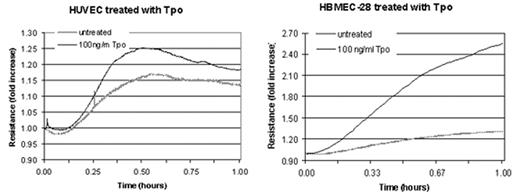Abstract
In addition to hematopoietic cells, the receptor for thrombopoietin (Tpo), c-Mpl, is expressed on human umbilical vein endothelial cells (HUVEC). In this study, we demonstrated that Mpl mRNA and protein can also be detected in immortalized human bone marrow endothelial cells (HBMEC). Furthermore, it was investigated whether Tpo affects endothelial monolayer integrity by either cell spreading or cell-cell contacts. By continuously monitoring the electrical resistance of freshly plated HUVEC or HBMEC with ECIS (electric cell-substrate impedance sensing), we observed a significant increase in the electrical resistance when endothelial cells were treated with 100 ng/ml of Tpo just prior to seeding, as shown in the figure below. This increase in electrical resistance was not due to increased cell adhesion or proliferation of the endothelial cells. However, a significant increase in initial spreading could be detected. Besides its effect on spreading, Tpo increased the electrical resistance of a confluent endothelial monolayer when compared to untreated monolayers. This indicates that Tpo promotes the formation of endothelial cell-cell contacts. Indeed, a decrease in immunostaining levels of phosphotyrosine could be observed in monolayers treated with Tpo. Also the junctional protein VE-cadherin showed diminished co-localization with phosphotyrosine staining when cells were treated with Tpo. The small GTPase Rap1 plays an important role in the formation of endothelial cell-cell contacts. In a pull-down experiment, using RalGDS as bait for active Rap1, we could demonstrate that Tpo transiently activates Rap1 in HUVEC. Thus, these results may put Tpo forward as a regulator of endothelial cell-cell contacts, possibly after vascular damage and subsequent release of Tpo by activated platelets. To our knowledge, Tpo is the first cytokine exerting this effect on endothelial cells.
Author notes
Disclosure: No relevant conflicts of interest to declare.


This feature is available to Subscribers Only
Sign In or Create an Account Close Modal